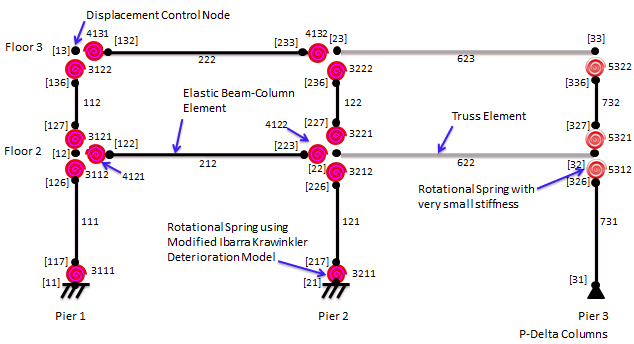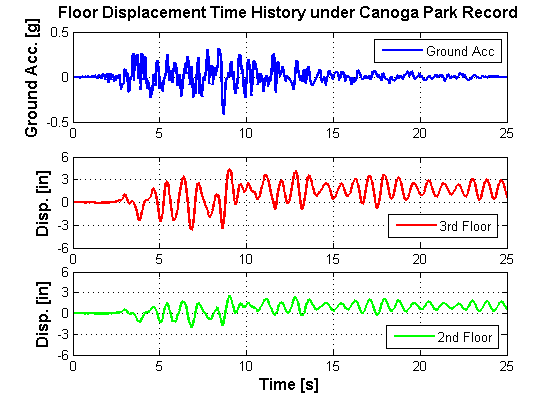Dynamic Analysis of 2-Story Moment Frame: Difference between revisions
m (→Recorders) |
m (→References) |
||
| Line 65: | Line 65: | ||
== References == | == References == | ||
# Ibarra, L. F., and Krawinkler, H. (2005). “Global collapse of frame structures under seismic excitations,” Technical Report 152, The John A. Blume Earthquake Engineering Research Center, Department of Civil Engineering, Stanford University, Stanford, CA. [electronic version: | # Ibarra, L. F., and Krawinkler, H. (2005). “Global collapse of frame structures under seismic excitations,” Technical Report 152, The John A. Blume Earthquake Engineering Research Center, Department of Civil Engineering, Stanford University, Stanford, CA. [electronic version: https://blume.stanford.edu/tech_reports] | ||
# Ibarra, L. F., Medina, R. A., and Krawinkler, H. (2005). “Hysteretic models that incorporate strength and stiffness deterioration,” Earthquake Engineering and Structural Dynamics, Vol. 34, 12, pp. 1489-1511. | # Ibarra, L. F., Medina, R. A., and Krawinkler, H. (2005). “Hysteretic models that incorporate strength and stiffness deterioration,” Earthquake Engineering and Structural Dynamics, Vol. 34, 12, pp. 1489-1511. | ||
# Lignos, D. G., and Krawinkler, H. (2009). “Sidesway Collapse of Deteriorating Structural Systems under Seismic Excitations,” Technical Report 172, The John A. Blume Earthquake Engineering Research Center, Department of Civil Engineering, Stanford University, Stanford, CA. | # Lignos, D. G., and Krawinkler, H. (2009). “Sidesway Collapse of Deteriorating Structural Systems under Seismic Excitations,” Technical Report 172, The John A. Blume Earthquake Engineering Research Center, Department of Civil Engineering, Stanford University, Stanford, CA. | ||
# Lignos, D. G., and Krawinkler, H. (2010). “Deterioration Modeling of Steel Beams and Columns in Support to Collapse Prediction of Steel Moment Frames,” ASCE, Journal of Structural Engineering (under review). | # Lignos, D. G., and Krawinkler, H. (2010). “Deterioration Modeling of Steel Beams and Columns in Support to Collapse Prediction of Steel Moment Frames,” ASCE, Journal of Structural Engineering (under review). | ||
# Zareian, F. and Medina, R. A. (2010). “A practical method for proper modeling of structural damping in inelastic plane structural systems,” Computers & Structures, Vol. 88, 1-2, pp. 45-53. | # Zareian, F. and Medina, R. A. (2010). “A practical method for proper modeling of structural damping in inelastic plane structural systems,” Computers & Structures, Vol. 88, 1-2, pp. 45-53. | ||
Revision as of 22:00, 24 September 2010
Example posted by: Laura Eads, Stanford University
This example demonstrates how to perform a dynamic analysis in OpenSees using a 2-story, 1-bay steel moment resisting frame. The structure is subjected to the Canoga Park record from the 1994 Northridge earthquake. The nonlinear behavior is represented using the concentrated plasticity concept with rotational springs. The rotational behavior of the plastic regions follows a bilinear hysteretic response based on the Modified Ibarra Krawinkler Deterioration Model (Ibarra et al. 2005, Lignos and Krawinkler 2009, 2010). For this example, all modes of cyclic deterioration are neglected. A leaning column carrying gravity loads is linked to the frame to simulate P-Delta effects.
The files needed to analyze this structure in OpenSees are included here:
- The main file: MRF_2Story_Concentrated.tcl
Supporting procedure files
- DisplayModel2D.tcl – displays a 2D perspective of the model
- DisplayPlane.tcl – displays a plane in the model
- rotSpring2DModIKModel.tcl – creates a bilinear rotational spring that follows the Modified Ibarra Krawinkler Deterioration Model (used in the concentrated model)
- rotLeaningCol.tcl – creates a low-stiffness rotational spring used in a leaning column
The acceleration history for the Canoga Park record
- NR94cnp.tcl - contains acceleration history in units of g
All files are available in a compressed format here: dynamic_example.zip
The rest of this example describes the model and shows the analysis results.
Model Description

The 2-story, 1-bay steel moment resisting frame is modeled with elastic beam-column elements connected by zeroLength elements which serve as rotational springs to represent the structure’s nonlinear behavior. The springs follow a bilinear hysteretic response based on the Modified Ibarra Krawinkler Deterioration Model. A leaning column with gravity loads is linked to the frame by truss elements to simulate P-Delta effects. An idealized schematic of the model is presented in Figure 1.
A leaning column with gravity loads is linked to the frame by truss elements to simulate P-Delta effects. To simplify this model, panel zone contributions are neglected, plastic hinges form at the beam-column joints, and centerline dimensions are used. Subsequent examples will explicitly model the panel zone shear distortions and include reduced beam sections (RBS). The units of the model are kips, inches, and seconds.
For a detailed description of this model, see Pushover Analysis of 2-Story Moment Frame.
Damping and the Rayleigh Command
This model uses Rayleigh damping which formulates the damping matrix as a linear combination of the mass matrix and stiffness matrix: c = a0*m + a1*k, where a0 is the mass proportional damping coefficient and a1 is the stiffness proportional damping coefficient. A damping ratio of 2%, which is a typical value for steel buildings, is assigned to the first two modes of the structure. The rayleigh command allows the user to specify whether the initial, current, or last committed stiffness matrix is used in the damping matrix formulation. In this example, only the initial stiffness matrix is used, which is accomplished by assigning values of 0.0 to the other stiffness matrix coefficients.
To properly model the structure, stiffness proportional damping is applied only to the frame elements and not to the highly rigid truss elements that link the frame and leaning column, nor to the leaning column itself. OpenSees does not apply stiffness proportional damping to zeroLength elements. In order to apply damping to only certain elements, the rayleigh command is used in combination with the region command. As noted in the region command documentation, the region cannot be defined by BOTH elements and nodes. Because mass proportional damping assigns damping to nodes with mass, OpenSees will ignore any mass proportional damping that is assigned using the rayleigh command in combination with the region command for a region of elements. Therefore, if using the region command to assign damping, the mass proportional damping and stiffness proportional damping must be assigned in separate steps.
Modifications to the Stiffness Proportional Damping Coefficient
As described in the “Stiffness Modifications to Elastic Frame Elements” section of Pushover Analysis of 2-Story Moment Frame, the stiffness of the elastic frame elements has been modified. As explained in Ibarra and Krawinkler (2005) and Zareian and Medina (2010), the stiffness proportional damping coefficient that is used with these elements must also be modified. As the stiffness of the elastic elements was made “(n+1)/n” times greater than the stiffness of the actual frame member, the stiffness proportional damping coefficient of these elements must also be made “(n+1)/n” times greater than the traditional stiffness proportional damping coefficient.
Dynamic Analysis
Recorders
The recorders used in this example include:
- The drift recorder to track the story and roof drift histories
- The node recorder to track the floor displacement and base shear reaction histories
- The element recorder to track the element forces in the first story columns as well as the moment and rotation histories of the springs in the concentrated plasticity model
For the element recorder, the region command was used to assign all column springs to one group and all beam springs to a separate group.
It is important to note that the recorders only record information for analyze commands that are called after the recorder commands are called. In this example, the recorders are placed after the gravity analysis so that the steps of the gravity analysis do not appear in the output files.
Analysis
The structure is analyzed under gravity loads before the dynamic analysis is conducted. The gravity loads are applied using a load-controlled static analysis with 10 steps. So that the gravity loads remain on the structure for all subsequent analyses, the loadConst command is used after the gravity analysis is completed. This command is also used to reset the time to zero so that the dynamic analysis starts from time zero.
For the dynamic analysis, the structure is subjected to the Canoga Park record from the 1994 Northridge earthquake. To apply the ground motion to the structure, the uniform excitation pattern is used. The name of the file containing the acceleration record, timestep of the ground motion, scale factor applied to the ground motion, and the direction in which the motion is to be applied must all be specified as part of the uniform excitation pattern command.
To execute the dynamic analysis, the analyze command is used with the specified number of analysis steps and the timestep of the analysis. The timestep used in the analysis should be less than or equal to the timestep of the input ground motion.
Results

The floor displacement histories from the dynamic analysis are shown in Figure 2. The top graph shows the ground acceleration history while the middle and bottom graphs show the displacement time histories of the 3rd floor (roof) and 2nd floor, respectively.
References
- Ibarra, L. F., and Krawinkler, H. (2005). “Global collapse of frame structures under seismic excitations,” Technical Report 152, The John A. Blume Earthquake Engineering Research Center, Department of Civil Engineering, Stanford University, Stanford, CA. [electronic version: https://blume.stanford.edu/tech_reports]
- Ibarra, L. F., Medina, R. A., and Krawinkler, H. (2005). “Hysteretic models that incorporate strength and stiffness deterioration,” Earthquake Engineering and Structural Dynamics, Vol. 34, 12, pp. 1489-1511.
- Lignos, D. G., and Krawinkler, H. (2009). “Sidesway Collapse of Deteriorating Structural Systems under Seismic Excitations,” Technical Report 172, The John A. Blume Earthquake Engineering Research Center, Department of Civil Engineering, Stanford University, Stanford, CA.
- Lignos, D. G., and Krawinkler, H. (2010). “Deterioration Modeling of Steel Beams and Columns in Support to Collapse Prediction of Steel Moment Frames,” ASCE, Journal of Structural Engineering (under review).
- Zareian, F. and Medina, R. A. (2010). “A practical method for proper modeling of structural damping in inelastic plane structural systems,” Computers & Structures, Vol. 88, 1-2, pp. 45-53.